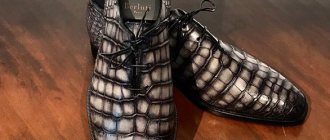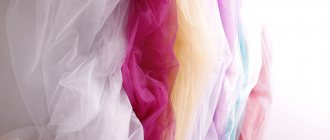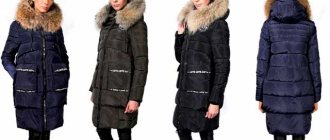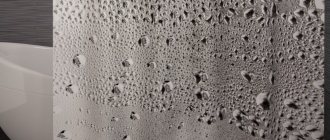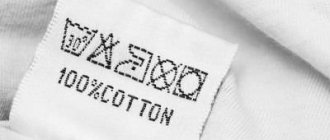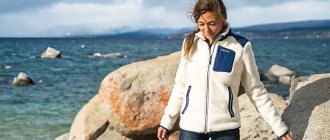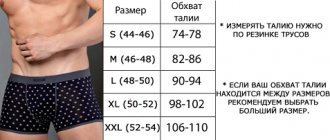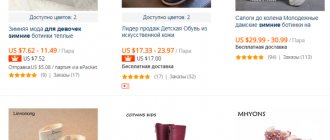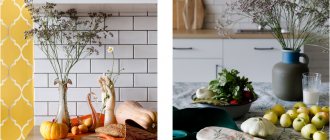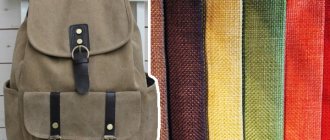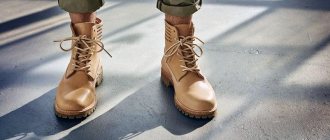What lining materials are used in shoe production today?
Modern lining materials for shoes sometimes have unique properties: they can “breathe”, remove excess moisture, regulate heat exchange, retaining heat and keeping cold out. Along with natural materials, artificial and synthetic ones are quickly used. The main tasks that lining materials solve are to provide comfort, coziness and warmth to a person when wearing shoes. These characteristics are especially important in the harsh climatic conditions of our country. Igor Okorokov is a shoe production engineer, a graduate of the Vitebsk State Technological University of Light Industry. Since 2002, he has been working as a specialist for various shoe companies in Russia.
What requirements must modern lining materials meet?
• have sufficient thickness - to protect the foot from rubbing with seams and unevenness of the workpiece; • have softness and flexibility - to ensure comfort when wearing shoes; • be durable and not have crumbling edges - to preserve the integrity of the lining and ensure reliable strength of the thread seams connecting the individual parts of the lining to each other and to the external parts of the shoe upper; • have the highest possible abrasion resistance;
• be resistant to sweat, moisture and heat, do not change color with dry and wet friction, do not stain stockings and socks, do not contain substances harmful to the feet;
• have greater or lesser heat-protective properties, depending on the seasonal purpose of the shoes; • have a good appearance, uniformly painted surface.
In expensive shoes, the lining is usually made of leather, in cheaper models - from a combination of leather + fabric, or only from fabric, or from artificial leather. In winter shoes, the lining is made from heat-protective materials: natural, artificial and woolen fur, from wool blend fabrics for the spring-autumn period. Also, shoes can be unlined; these are, as a rule, shoes for the summer season.
Membrane for dryness, warmth and comfort
To obtain maximum comfort and ensure the removal of moisture from the inner space of shoes, manufacturers use so-called “breathable” membrane-type materials for lining shoes, which improve hygienic properties compared to the use of natural and, especially, synthetic leather. The use of cellular materials as lining promotes better air circulation and cooling of the skin; the use of perforated insoles improves the removal of moisture vapor from the surface of the foot.
Let's look at the main modern membrane-type materials.
Cambrelle
- a textile material similar in strength to leather for making shoe linings and insoles. Soft to the touch, abrasion resistant, with good antibactericidal and antifungal properties. It looks like a sponge - very porous, it can absorb three times more moisture than it weighs. The material dries quickly and allows air to circulate, so shoes with this lining keep your feet dry and comfortable all day long.
The material is used in the production of special, tourist, sports and work shoes. Main advantages:
- It is highly hygroscopic and dries quickly;
- “breathable”, breathable;
- abrasion resistant;
- pleasant to the touch.
Thinsulate
– a good thermal insulation material, a synthetic analogue of eider down, superior to down in many characteristics. The material is a unique combination of heat-protective and ventilating properties - while reliably retaining heat, it allows excess moisture to evaporate freely. Provides complete comfort, allowing you to ignore any adverse weather conditions, including the most severe frosts. Even a thin layer of this microfiber insulation has amazing thermal insulation properties, combined with durability, unpretentiousness and ease of care, it is the optimal lining material for children's and adult shoes.
Core-Tex
– “breathable” membrane-type material, consists of three layers: outer fabric, membrane and inner fabric (lining). The smallest pores do not allow water molecules to penetrate inside the shoe, but freely allow water vapor to pass out. The material can withstand pressure up to 6,000 mm of water column, keeping your feet dry.
The GORE-TEX membrane is a very thin film of fluoroplastic with more than 1.4 billion pores per 1 square meter. cm. The pore size is approximately 20,000 times smaller than the size of a drop of water, but 700 times larger than the size of a water vapor molecule. Thus, the membrane retains water, and steam can pass through it unhindered. The result is a high-tech material that is resistant to moisture, protects from cold, retains heat, and provides breathability.
Winter models use multilayer material with a GORE-TEX membrane with high thermal insulation and insulation that allows you to retain heat even in very severe frosts. There are various GORE-TEX materials used in the production of shoes designed to withstand different temperature conditions. Thus, shoes with GORE-TEX Extended Comfort are ideal for moderate to warm conditions. It is suitable for intense sports and daily use. The technology behaves perfectly when you are at home and when you are outside, when you are standing and when you are walking, working and relaxing. GORE-TEX Surround is essentially a multi-layer lining. Integrated into the cuff, it allows the shoe to fit well on the foot, tightly fitting it and providing absolute water resistance and high breathability. This material keeps your feet dry and prevents them from overheating. GORE-TEX Insulated Comfort shoes feature a variety of insulation options to keep feet dry and warm in cold conditions and during a variety of winter outdoor activities. GORE-TEX Performance Comfort shoes provide ideal comfort in moderate weather conditions and a wide variety of outdoor activities.
The principle of multi-layering
In recent years, some types of safety footwear have used multi-layer materials, used as a lining system in the form of an inner boot inserted into the safety footwear. The inner layer, made from polypropylene fibers, transfers moisture well to the outer layer. The intermediate layer, which retains and retains heat, is made of natural wool felt and nylon thermofoil, which prevents the penetration of cold. To regulate and maintain a certain temperature, another porous layer (Comfortemp) based on polyurethane with microcapsules, which are set to a certain temperature when created, can be introduced into the shoe. Similar materials are used for the special inner insole. If the temperature in the interior of the shoe drops below a set point, the capsules begin to slowly release heat. A special feature of Comfortemp is that the properties of the system can be restored by returning to a warm room for a short time.
This article was published in issue 134 of the print version of the magazine.
What are membrane shoes and what is the secret of their popularity?
Image provided by the manufacturers of children's membrane shoes TM Shalunishka (Kangaroo)
The membrane is a multilayer tissue with microscopic pores. Depending on the type of membrane fabric, it may contain 3 or more layers, but the principle of operation of all membranes is similar: micropores are so small in size that moisture (water) in a liquid state cannot penetrate through them, but steam passes through perfect.
In shoes, membrane fabric in the form of a kind of stocking, taking into account the characteristics of a particular model, is placed between the outer and inner material, so it is impossible to visually determine its presence (we will talk about this a little later). While wearing shoes, the air inside them heats up from the heat of the human body and, naturally, sooner or later becomes humid.
The vapor-permeable properties of the membrane fabric safely remove the steam formed inside the boot or boot to the outside according to the simple laws of equilibrium - heated water molecules in a vaporous state rush from the area of high pressure inside the shoe beyond its limits - into the area of lower pressure and temperature. At the same time, natural moisture from the outside does not penetrate into the product - it cannot seep through micropores.
As a result, it turns out that a unique microclimate is formed inside the membrane shoes; the feet do not freeze or sweat throughout the entire time they are worn. It is this property of membrane shoes that gives them such a high value in the eyes of buyers. And of course, the opportunity to save money on purchasing several pairs of shoes or boots in one season, which quickly lose their attractive appearance due to moisture.
Materials for making shoes
Leather
A strong and flexible durable material obtained by tanning hides in a traditional economy or industrial enterprise.
Artificial leather (IR)
A polymer material used instead of genuine leather for the manufacture of shoes, clothing, haberdashery and technical products.
Patent leather (LAC)
Shoe and clothing leather, which differs from ordinary chrome-tanned leather mainly only in finishing (the presence of a varnish film on the front surface - oil, polyurethane, nitrocellulose, mixed, etc.). L.K. should be soft with a uniform shiny varnish film.
Recycled leather
It is made from tannery waste - scraps of natural leather, which, during the grinding process, are converted into fibrous powder, which is subsequently glued together using latex or other adhesive materials. This makes it possible to obtain a material that is close to natural leather in terms of elasticity and strength, and has the smell of tanned leather. Thus, recycled leather is a cross between natural and artificial leather.
Suede
Soft, velvety leather produced by fat and formaldehyde-fat tanning from the skins of any not very large animals.
Faux suede
Fabric having a satin weave of fibers and undergoing double finishing: brushing and finishing.
Fur, wool
Skin hair in animals other than humans.
Faux fur, wool (faux fur, artificial wool)
Textile material imitating natural animal fur. Made from viscose.
Felt
Thick non-woven textile material made from felted wool.
Felt
Types of felt made from fine down of rabbits or goats.
Velours
Felt with short, thick and soft pile.
Textile
Products made from flexible, soft fibers and threads (fabric, wadding, nets, etc.), usually made from yarn on a loom. Textiles also include matter that is not fabric: knitwear, felt, modern non-woven materials, etc.
Chemical fibers (synthetic material)
Textile fibers obtained from natural and synthetic organic polymers, as well as inorganic compounds.
Reaper
Thin curtain fabric made of chemical fibers, usually polyester, with a shiny surface. The header effect is achieved through heat treatment and does not disappear when washed. The header is a cotton fabric with a special treatment - a “crinkling” effect, which gives the linen special strength and durability, and this fabric does not require ironing.
Nylon
Durable, lightweight and elastic material of different weaving densities of artificial fiber threads based on polyamides.
Oxford fabric
Very durable fabric. It is based on polyester or nylon fibers. They give a bright texture, smoothness and shine. This composition of the material indicates durability and lack of tendency to abrasion during prolonged use. It is used for sewing casual clothing, workwear, and travel equipment.
Raincoat
Fabric consisting of natural cotton and any synthetic fibers with the use of special impregnation to enhance the water-repellent effect.
Membrane
A very thin polymer film with microscopic holes called pores. The shape of the pores is such that it provides the material with one-way water permeability, excellent protection from wind and allows the material to “breathe”.
Fleece
Synthetic knitted polyester fabric for making warm clothing.
Sintepon
Lightweight, voluminous, elastic non-woven material. In the production of padding polyester, the method of thermal bonding of polyester fibers is used, which allows it to maintain softness and elasticity.
Warm stocking
Felt stocking. Used to protect feet from low temperatures.
Bamboo fiber (bamboo)
Regenerated cellulose fiber made from bamboo stem. Its thinness and whiteness resembles viscose and has higher strength. There are two methods for producing bamboo fiber from bamboo, each of which is preceded by grinding the bamboo.
Injection method of fixing the sole (injection)
Attaching the sole to a leather product using direct casting. A material or substance in a viscous-flowing or liquid low-viscosity state fills the mold and then, with increasing viscosity, is molded, taking on the geometric image of the internal space of the mold. A specific application of injection molding methods in shoe manufacturing is the molding of the bottom directly onto the shoe while simultaneously attaching it to the footprint. This is the so-called injection molding method for attaching the bottom of the shoe.
EVA (ethylene vinyl acetate)
Environmentally friendly, highly efficient foam rubber is a composite polymer material related to polyolefins.
Foam rubber
Elastic porous material made from latex or hard rubber.
Polyurethane (PU)
A polymer with a porous structure, high mechanical strength and low weight. Foamed polyurethane has excellent thermal insulation (from –10 to +100°C), which makes the sole soft, flexible, with excellent shock-absorbing properties; in addition, this material is moisture-proof and is not afraid of the effects of petroleum products, acid and alkali solutions.
Rubber
It is vulcanized rubber with additives that give it certain properties. The rubber mixture includes vulcanizing agents, accelerators, activators, fillers, plasticizers, blowing agents, pigments and dyes, antiaging agents, as well as other additives that give it the necessary performance properties. This material is better than others for the soles of work shoes: slip-resistant, durable, frost-resistant, oil- and petrol-resistant and acid-alkali-resistant. Some types of rubber soles are heat resistant up to +300ºС.
